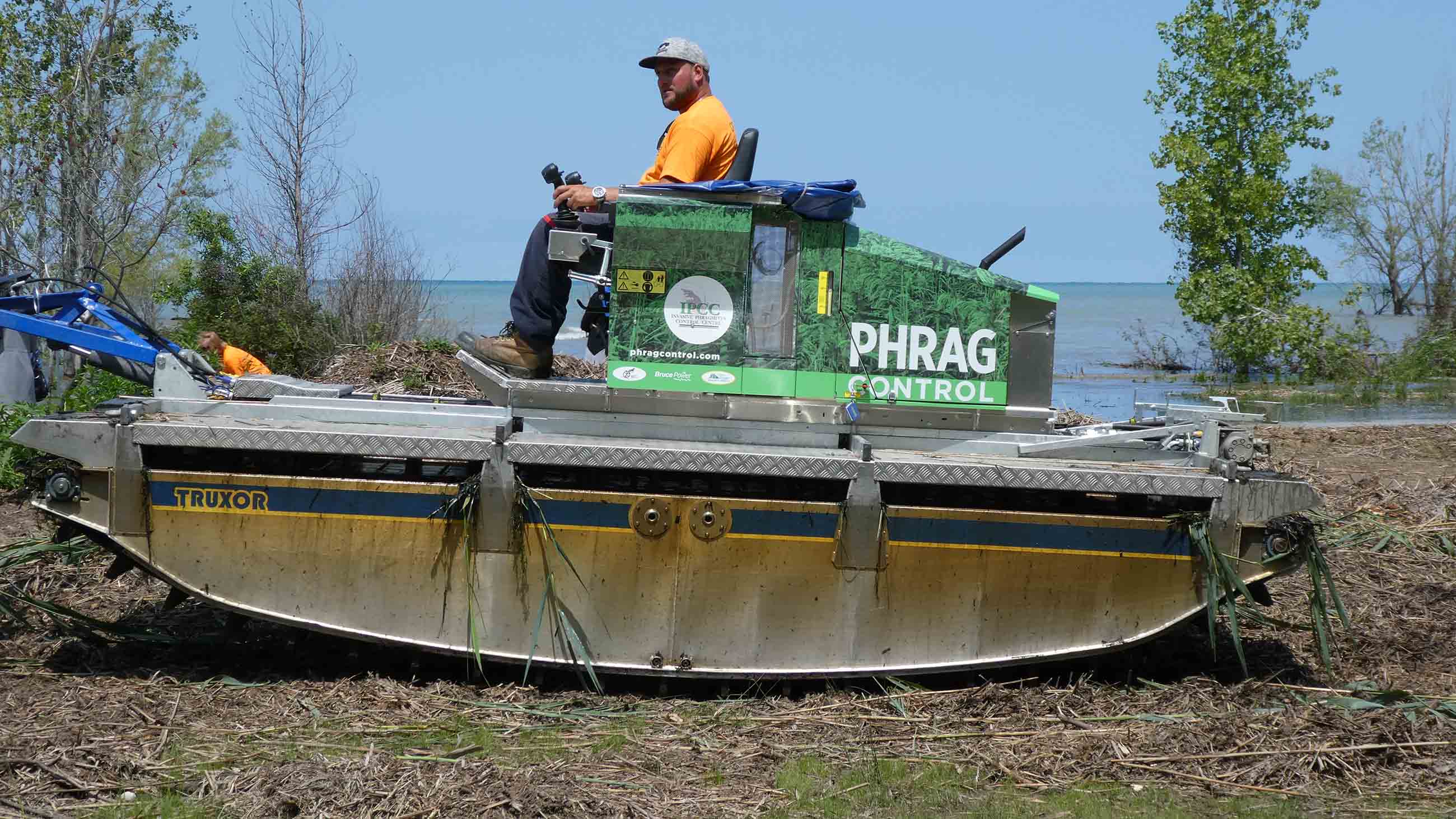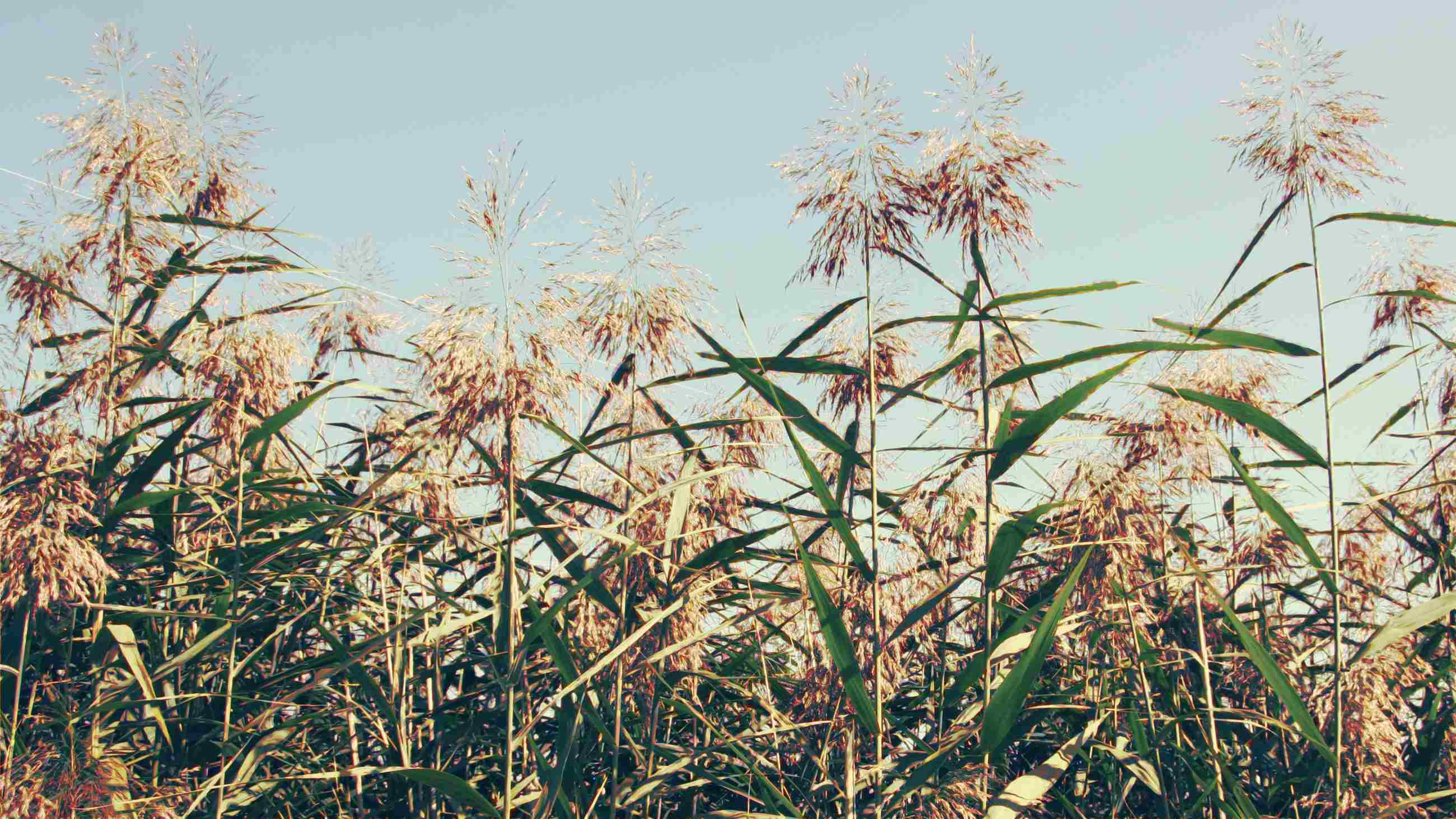In Canada, the Search for a ‘Phrag’ Destroyer
It’s a bright day on the southern shore of Lake Huron, roughly 30 miles northeast of the United States border. Here in Ontario, Canada, two amphibious vehicles called Truxors paddle through shallow water. One uses blades off its stern to chop dense clumps of tall grass. The other rakes up the cut Phragmites australis — which everyone calls “phrag” — and hauls the thick stalks back to a pile on shore.
Nearby, people in chest waders wield power tools or raspberry cane cutters to snip smaller batches of phrag just above sediment level, drowning the plants. On shore, volunteers attack phrag stems with spades. Wetland ecologist Janice Gilbert, who founded and runs the nonprofit Invasive Phragmites Control Center, stands near a pickup, directing people and handing out equipment.
While this is a volunteer appreciation day, complete with a barbecue and free T-shirts, it’s also a work day. And the work to get rid of the phrag is never done. Phrag can reach heights of 20 feet, and it can grow as rapidly as 1.5 inches a day, throwing up a new shoot every 10 inches from its runners. The plant spreads mostly through the dispersal of seeds through the air, but roadside phrag will also shed seeds that land on the tires of pulled-over cars and highway maintenance vehicles, getting a lift to new locations like farms and waterways. It takes over animal habitats, driving snakes and birds away and emits toxins that kill other plants. On the side of the road, it’s a fire hazard that prevents proper drainage, blocks sight-lines, and even slows paramedics extracting people from their cars after accidents. Since 80 percent of the plant resides below ground, it takes years for the biomass to go away — even after cutting or drowning.
It’s a dilemma that communities across North America have been grappling with for nearly two decades, and the Canadian government has gone so far as to list the grass — also known as the common European reed — as the most invasive plant in the country. “People just want it gone,” says Nancy Vidler, co-founder and chair of the Lambton Shores Phragmites Community Group, who organized this event and hired Gilbert.
The problem: Getting rid of it manually takes time and money. Of the 223 acres of phrag choking the Lake Huron shoreline in this one Ontario municipality, Vidler and Gilbert estimate they’ve culled about a third in five years. But things are moving faster further south, on Lake Erie, where a pilot project is experimenting with herbicides to eliminate phrag.
In 2016, Ontario’s Ministry of Natural Resources and Forestry obtained an emergency use permit from the federal government and has been spraying annually ever since in and around the provincial parks at Rondeau Bay and Long Point. As part of the pilot, the federal government is demanding strict tracking of chemicals and the protection of native plants and animals.
The resulting data plus Gilbert’s growing understanding of how to nix phrag manually, could prove a boon to those fighting this invader on both sides of the border. (Indeed, phrag has also spread on the U.S. side of the Great Lakes and is all over the eastern seaboard, though fewer rules around herbicides means the plant is often readily treated with chemicals.)
In Canada, the new insights can’t come soon enough. “When we do public open houses [as part of a pilot project to spray phrag] we are nervous that everyone is going to be mad at us for spraying plants near water,” says Eric Cleland, who works with the nonprofit Nature Conservancy of Canada. “Instead, we have people coming out saying they are mad they were not spraying the phrag by their place first.”

This particular strain of phrag originally came to North America on ships more than a hundred years ago, and while it’s an annoyance virtually everywhere, plants and animals are adapted to it in its native European habitats. Turtles know how to nest in it, for example, and people even use phrag’s thick stems to make fences and thatched roofs.
In North America, however, turtles get flipped sideways and die in invasive phrag, while North American humans have found no use for the cut plant.
Phrag began appearing in the Great Lakes and St. Lawrence River region decades ago, but in 1999, water levels went down, leaving fertile mud flats. “They can get a foothold and can grow rapidly,” says McMaster University biology professor Pat Chow-Fraser. Ironically, phrag flourishes when humans take over new habitats. Road building and maintenance, new home construction, and automobile traffic in the increasingly dense human population in southern Ontario all helped phrag extend its reach. Thanks to agricultural run-off, the region’s waterways are also rich in nutrients, so phrag thrives on shorelines, too. “They’re kind of like the rats of the plant world,” says Chow-Fraser.
She has been documenting phrag’s roadside presence in the province: there were 66 acres in 2006, and 642 by 2010. Phrag’s presence then doubled again over the next several years, so the government began removing it by cutting and spreading an herbicide, glyphosate, on dry ditches — plus ensuring drivers rinse their tires after roadside work, to stop the spread. In 2015, the amount of phrag on the side of Ontario’s roads seemed to be holding steady at 817 acres. Chow-Fraser is pushing to use remote sensing to track and protect the native species from carte blanche phrag removal, and also for transportation staff to nip small phrag cells early, before they get impossibly large and dense.
Meanwhile, on a good day, Gilbert’s crew can only drown 10 acres at a cost of about $6,500. Volunteers working manually go even slower. “If we had the right herbicide,” says Gilbert, “this area would be almost under control by now.”
That’s an odd thing for a wetland ecologist to say, especially in Canada, where herbicides are rarely used in water because they can harm marine life and contaminate municipal water systems. With minimal demand, manufacturers haven’t bothered to go through the Canadian approvals process. Consequently, there are no herbicides on the market for use in Canadian waters.
But scientists, activists, and residents fighting phrag agree: They want chemicals, especially for wetlands, because the risk associated with a phrag invasion overtakes worries about toxicity. Pong Point and Rondeau Bay on Lake Erie currently have about 70 percent phrag coverage, for example, but they are also home to numerous species at risk, and they play a key role in bird life and migration. Long Point has been designated a biosphere reserve by the United Nations Educational, Scientific, and Cultural Organization (UNESCO).
So in September 2016, the Ontario government used helicopters in these regions to spray a total of 1,250 acres with Roundup Custom, which is basically just glyphosate. The herbicide was mixed with the surfactant Aquasurf, an additive that helps the product penetrate into the plant that’s safer for aquatic life than traditional surfactants. In 2017, they treated another 1,500 acres, and in 2018 focused on touch-ups.
Rebecca Rooney, an assistant professor of biology at the University of Waterloo, has been studying the results. “There hasn’t been very rigorous monitoring of herbicide’s effect in invasive species control,” she notes, “even though it’s quite a common practice in the U.S.”
For the Ontario pilot project, the results so far seem promising Rooney said. That 2016 spray knocked out 99.7 percent of stem density in treated areas, for example. Water, sediment, and algae samples also suggest that glyphosate does not linger — after 30 days it was virtually gone. And while it’s too early to see native plants return, Rooney has been tracking barn swallows and the bugs they eat. Already the midge-like bugs have increased almost four-fold in sprayed areas.
The Ontario government must reapply for the pilot every year, but those involved expect the program to continue until 2020. Meanwhile, scientists in Canada hope that makers of water-friendly herbicides will apply to have their products approved. “As an ecologist, it’s an irony for me, basically begging Monsanto to use its product in Canada,” says Rooney.
In the meantime, the information gathered in Ontario should help everyone better understand phrag elimination.
“It’s about weighing the known negative impact of phrag invasion on biodiversity and the health of an ecosystem,” Rooney said, “against the risks of exposing our environment to herbicides.”
Diane Peters is a Canadian writer and editor. She teaches at Ryerson University in Toronto.











Comments are automatically closed one year after article publication. Archived comments are below.
I’m glad Canada is working out methods to control invasive Phragmites australis australis.
You write that Canada has no use for phragmites. What about composting and biofuel? It seems a waste to destroy so much organic matter without giving much thought to how it might be used.
Evidence of the glyphosate aerial bombing damage can be viewed on the “Friends of Rondeau Bay” Facebook Page
Application of herbicides into the Rondeau Bay wetland ecosystem has had a devastating effect on the ecology. This was little more than a cosmetic pesticide application aimed at gaining government support for yet another War on Plants.
The fanatical mass spraying of a non selective herbicide and carcinogen into the last natural wetlands along lake Erie has killed many rare native species lost as Collateral Damage.
What is is is a Growth Market for Pesticide applicator’s whose business model was curtailed with the Ontario Cosmetic Pesticide Ban legislation.